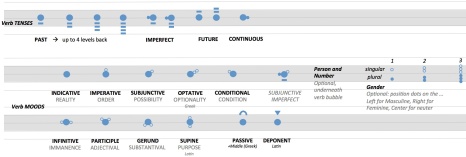Verbs are the soul of Language. By describing action or existence, they deal with the magical properties of Life. Without them there would be no sentences: only catalogues, inventories and lists.
A humble word, the verb is a marriage of space and time: Einstein’s relativity enshrined in Language.
In a sentence, verbs describe the action and are essential to unlock meaning (e.g.: “John LOVES Mary” vs “John HATES Mary”).
Generally, each sentence has one, and only one, verb at its core. This is why verbs take centre stage in ToB: prominent fubbles right in the middle of the pentagram.
Shape-shifting Timelords
This picture shows various examples of the action of “going”: they differ in terms of when it happens and who does it.
Each separate time reference is given a different shape (after all, in plain language the same verb can take radically different “shapes” according to time, e.g.: “I go”, “I went”):
- present = plain fubble;
- future = fubble+1, fubble+2;
- past = fubble-1, fubble-2…
Sometimes the “verb shape” requires using multiple words, such as “have gone”, “will go”, “could have gone”. The above examples show how we deal with this in ToB: fubbles for the “primary” verb-word (“gone”, “go”) and smubbles for the “secondary” ones, with “joining lines” above or below to indicate that we are dealing with the “same bubbly family”.
You can also see up to three smebbles (singular) or smubbles (plural) underneath the main fubbles: these are optional indicators describing who carries out the action (I, you, …, they), a distinction that is more important in languages other than English.
…and verbs are Moody too!
Verbs also describe mood or intention. The main moods are:
- Indicative (or mood of reality, as in all the examples in the picture at the top);
- Imperative (used when issuing orders, as in “go!“);
- Conditional (when describing an action carried out on condition, such as “I would go if…”;
- Subjunctive (for desire or belief …in English this is rarely distinguishable from the indicative past, but “I wish you were” is a good example where this mood stands out);
- Infinitive (“to be or not to be” …easy: just add “to” before the verb!)
- Gerund (“going“, sometimes used instead of a noun “the going is tough” )
- Participle (in the present tense, in English, it’s indistinguishable from the gerund in terms of spelling 😦 …It may help to remember that it is often used as an adjective, as in the “easy-going man”; the past is easier, i.e. “gone”… as in many languages, the past participle is used in composite verbal forms, as in “I have gone”).
In ToB, verb moods are smebbles positioned on the outside perimeter of the main fubble: one or two, except for the indicative which has no smebble. See the examples above: at the top for imperative, top-left for conditional, and so on…
As a final, comprehensive summary, please refer to the picture below: a true bubble-fest. 
Want to try Tower of Bubble (ToB)? Download the Template | Cheat Sheet (Key Symbols)


